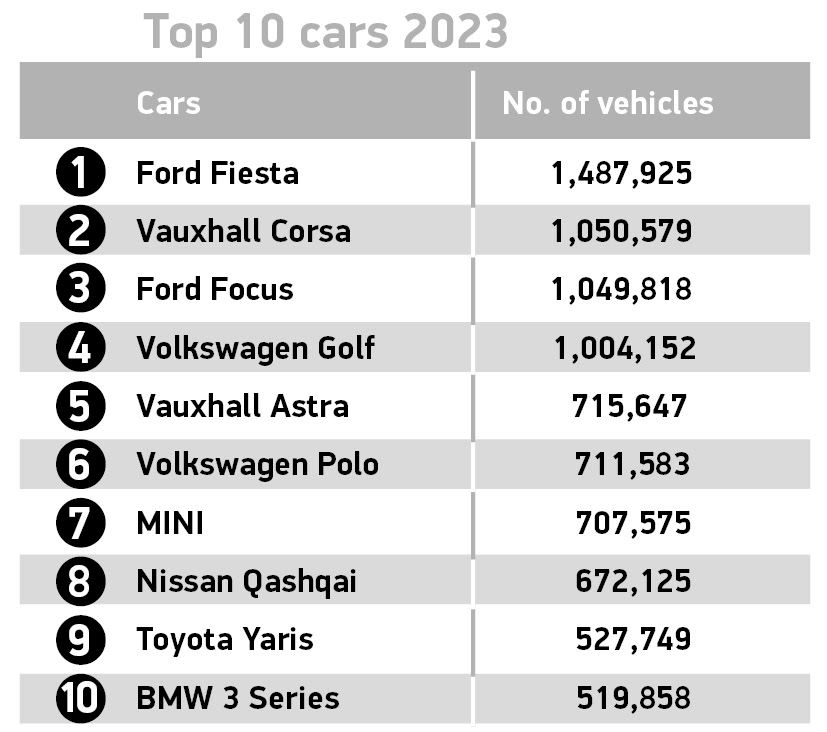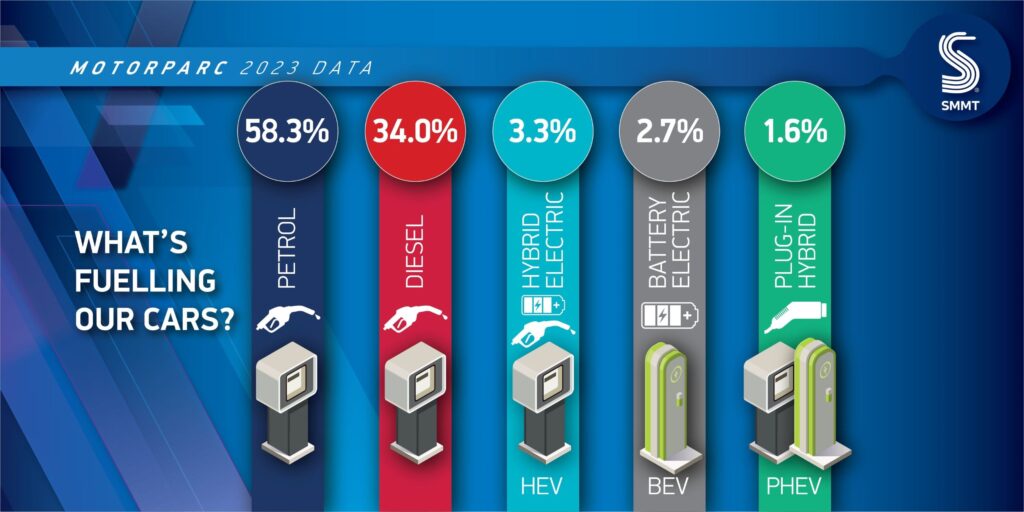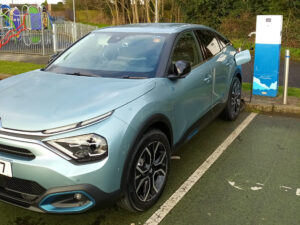The number of vehicles on UK roads reached a record high in 2023, rising by 1.7% to 41,404,589 vehicles.
This is according to new Motorparc data published today by the Society of Motor Manufacturers and Traders (SMMT) with plug-in vehicles driving the biggest growth in car ownership since 2016.1
Total cars on the road rose by 1.6% or 546,800 units to 35,694,845, after almost half a million new battery electric (BEV) and plug-in hybrid (PHEV) vehicles were registered during 2023.2 The number of BEVs in use increased by almost half (47.3%) compared with 2022, meaning these vital zero emission vehicles now account for 2.7% of all cars in use, up from just 1.9% in 2022.

With the industry now largely recovered from previous supply chain challenges that constricted deliveries in the aftermath of the pandemic, manufacturers could better meet robust pent-up demand. Implied scrappage rates of older vehicles has also fallen to the lowest on record with British motorists keeping their cars for longer, with the average car on the road now nine years old, with the average age of a car now up by more than a year since 2019.3
Despite a record number of motors on the road, average car CO2 dropped -2.1%, while company car emissions plummeted by -11.5%, thanks to compelling fiscal incentives encouraging fleets to invest in EVs and manufacturer investment in new lower and zero emission models.4 Providing private consumers with similar incentives to switch would help dramatically decarbonise UK road transport.

Record numbers of commercial vehicles are now in use, with 625,873 heavy goods vehicles and 5,012,632 vans in operation, up by 1.7% and 2.6% respectively. Zero emission workhorses also recorded a boost, with BEV van volumes rising by 43.5% on 2022 to 61,161, meaning 1.2% of vans on UK roads is now zero emission. Electric HGVs rose 146.4% in 2023, although at just 0.4% of the fleet, urgent action is therefore required on grants and infrastructure, especially given that new trucks under 26 tonnes have the same end of sale date as cars and vans.
The number of electric buses in operation also grew, up by 159.4% to 1,922 units, making the UK Europe’s biggest market for zero emission buses and coaches. However, despite a record year of registrations in 2023, the UK’s public transport fleet has shrunk to its smallest level since records began at 71,239 vehicles. In further evidence of the need for greater investment in this sector, one in five buses in use is more than 18 years old.
While overall EV use continues to grow, with 1,602,334 plug-in cars, vans, trucks and buses in operation, public charge point rollout is still lagging. 2023 was the best year for public charge point rollout, but there is still just one standard public charger available for every 35 plug-in cars on the road, only a slight improvement from one for every 36 last year.5
The situation is even more challenging for commercial vehicles, with no clear national plan for van-specific charge points and just one dedicated public truck charging location for the entire country. With increasing numbers of electric cars and vans now being mandated for sale, the time to invest in infrastructure is now. That investment should be nationwide so that everyone, irrespective of vehicle type, location and accessibility, can access a reliable, convenient and affordable charging network.
Mike Hawes, SMMT Chief Executive, said, “After two challenging years of constrained supply, more people and businesses across the UK are now getting back behind the wheel and increasingly, opting for greener options. However, given the ageing fleet, we now need to encourage consumers and businesses who have deferred purchases of new cars, vans, trucks and buses to upgrade. A stronger and stable economy, coupled with reduced living costs, would boost consumer and business confidence, while compelling fiscal incentives would ensure that these purchases are emissions free. Not only would this accelerate the transition, fundamental to the UK’s net zero ambitions, but it would also stimulate the economy and enhance the wider environment in which we all live.”
Notes
- The five most popular cars on UK roads in 2023 accounted for over 5.3 million in use – these are the Ford Fiesta at 1,487,925, Vauxhall Corsa at 1,050,579, Ford Focus at 1,049,818, Volkswagen Golf at 1,004,152 and Vauxhall Astra with 715,647 in use.
- 35.1% of cars on the road are registered to women, compared with 51.1% to men – with the remainder either registered to companies or gender unlisted. This follows a rise of more than half a million women as registered keepers on 2018.6
- The highest number of cars in the UK reside in London and the South East (8,910,951), followed by the North West (3,959,236) and the South West (3,572,387).
- With electric vehicles increasing in popularity, manual transmissions have fallen to 63.5% of the parc, down from 66.0% in 2022.
- London and the South East is also the region with the highest volume of plug-in vehicles with over half a million (527,887) of these green vehicles making up 5.9% of all cars in the area.
- The UK might be the fifth rainiest country in Europe…yet that hasn’t stopped convertibles accounting for almost one in 35 cars on the road, with 1,022,849 in use – falling very slightly on 2022 by 0.1 percentage points.
- Continuing their domination, superminis remain the most popular car type on roads, with one in three drivers choosing these more compact vehicles to get around.
- You’re more likely to see a car or van painted white than in any other colour in the UK, with 8,187,012 of them on the roads. Black and grey come in second and third place at 7,609,015 and 6,792,003 units respectively.
- Almost 25,000 pink cars can be found on British roads – with four in five registered to women. Wales has the highest proportion of pink cars, accounting for 0.1% of those in use. Scotland has the highest proportion of red cars at 12.3%.
- 2023 may have had a record year of vehicle registrations, but the UK’s public transport actually recorded the smallest bus fleet level since records began at 71,239 vehicles, down from 72,766 in 2022 and over 100,000 in 2007.










